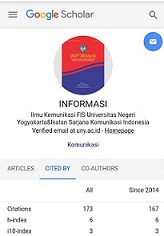ADOPTION OF INFORMATION AND COMMUNICATION TECHNOLOGY TO ENHANCE VETERINARY PHARMACOLOGY EDUCATION IN NIGERIAN UNIVERSITIES
DOI:
https://doi.org/10.21831/informasi.v48i2.23348Keywords:
Veterinary Pharmacology, e-Library, e-Learning, ICT, Nigerian UniversitiesAbstract
In resource-constraint countries like Nigeria, it is envisaged that the adoption of information and communication technology (ICT) in veterinary pharmacology education at university level can enhance both quality knowledge delivery and improve students' performance as well as ICT use skills. The literature consistently demonstrates that exposure to variety of digital and online educational resources and facilities encourages critical thinking among the students and enhance their independent problem-solving capabilities. It is long overdue cost-effective and efficient technology systems suitable for e-learning and teaching in Nigerian university education system, particularly in veterinary pharmacology academic context are explored. Emphasis should be placed on audio-visual e-learning systems such as large screen computer, digital projector and whiteboard in addition to constant power supply and Wi-Fi internet service. Being a medical course, veterinary pharmacology education will be immense enhanced if digital collaborative research and education systems are provided. To achieve this objective, relevant software and applications tailored to veterinary pharmacology students' specific needs in the e-education process are strongly recommended given the rapid innovations in the ICT sector, which is increasingly making both hardwater and software more affordable and user-friendly.
Di negara-negara dengan keterbatasan sumber daya seperti Nigeria, diperkirakan adopsi teknologi informasi dan komunikasi (TIK) dalam pendidikan farmakologi veteriner di tingkat universitas dapat meningkatkan penyampaian pengetahuan yang berkualitas dan dapat meningkatkan kinerja siswa serta keterampilan penggunaan TIK. Literatur secara konsisten menunjukkan bahwa paparan berbagai sumber daya dan fasilitas pendidikan digital dan sarana melalui (online) mendorong pemikiran kritis di antara siswa dan meningkatkan kemampuan pemecahan masalah independen mereka. Hal ini sudah lama diharapkan sebagai sebuah sistem teknologi yang hemat biaya dan efisien serta cocok untuk pembelajaran e-learning dan pengajaran di sistem pendidikan universitas Nigeria, terutama dalam konteks akademik farmakologi veteriner yang dieksplorasi. Penekanannya ditempatkan pada sistem-sistem perpustakaan dengan sistem online audio-visual seperti komputer layar besar, proyektor digital dan papan tulis di samping catu daya yang konstan dan layanan internet Wi-Fi. Melalui kursus medis, pendidikan farmakologi veteriner akan mudah ditingkatkan jika penelitian kolaboratif digital dan sistem pendidikan disediakan. Untuk mencapai tujuan ini, perangkat lunak dan aplikasi yang relevan yang disesuaikan dengan kebutuhan spesifik mahasiswa kedokteran hewan dalam proses e-edukasi sangat disarankan mengingat inovasi berkembang cepat di sektor TIK, yang semakin menjadikan air keras dan perangkat lunak lebih terjangkau dan ramah pengguna.
References
Adedoja, G., Botha, A., & Ogunleye, O. S. (2012). The future of mobile learning in the Nigerian education system. In P. Cunningham & M. Cunningham (Eds.), IST-Africa 2012 Conference Proceedings. IIMC International Information Management Corporation, 2012.
Adomi, E. E. & Kpangban, E. (2010). Application of ICTs in Nigerian secondary schools. Library Philosophy and Practice (e-journal), paper 345. Accessed from http://digitalcommons.unl.edu/libphilprac/345
Aduwa-Ogiegbean, S. E. & Iyamu, E. O. S. (2005). Using information and communication technology in secondary schools in Nigeria. Educational Technology & Society, 8(1), 104-112.
Agaga, L. A. & John, T. A. (2016 June). Conception of pharmacological knowledge and needs amongst Nigerian medical students at Lagos State University College of Medicine: Implication for future biomedical science in Africa. Nigerian Journal of Physiological Science, 31, 083-091.
Akinnaso, N. (2016 December 13). "˜What's your university's rank in the world?' Punch Nigeria. Accessed from https://www.punchng.com/
Al-rahmi, W. M., Othman, M. S., Yusof, L. M., & Musa, M. A. (2015). Using social media as a tool for improving academic performance through collaborative learning in Malaysian higher education. Review of European Studies, 7(3), 265-275. doi: 10.5539/res.v7n3p265
Babalobi, O. O. (2010). Internet web communication technology and information communication technology development and use for veterinary medicine education in Nigeria (2000-2009). Nigerian Veterinary Journal, 31(3), 185-194. doi: 10.4314/nvj.v31i3.68976
Carlile, S., Barnet, S., Sefton, A., & Uther, J. (1998). Medical problem based learning supported by intranet technology: A natural student-centered approach. International Journal of Medical Informatics, 50(1-3), 225-233
Chafe, A. I. (2010). Nigerian universities ICT solution project. PowerPoint slides presented at Nigerian Universities ICT Solution Project, NUC STEP-B Project Team. National Universities Commission (NUC), Abuja. Retrieved 17 November, 2018 from www.forum.org.ng
Enuku, U. A., & Enuku, O. (2000). Breaking down the walls: Computer application in correctional/prison education. Benin Journal of Educational Studies, 12/13(1/2), 64-71.
Federal Republic of Nigeria. (2004). National policy on education, 4th ed. Lagos: Nigerian Educational Research and Development Council.
Field, M. J. J. & Sefton, A. J. (1998). Computer"based management of content in planning a problem"based medical curriculum. Medical Education, 32(2), 163-171.
Ghosh, A., Mandal, K., Biswas, S., Dalui, S. K., Haldar, M., & Biswas, S. (2016). Evaluation of pharmacology teaching-learning methods in government medical colleges. International Journal of Basic and Clinical Pharmacology, 5(1), 126-130.
Goshit, T. (2006). Nigeria's need for ICT: ES.259 Technology and policy in Africa. In ES.259 information and communication technology in Africa, MIT Open courseware. Accessed from http://ocw.mit.edu/NR/rdonlyres/Special-Programs/SP-259Spring-2006/891209EE-E63B-4617-BA9D-7635A63C754B/0/goshit.pdf
Ibrahim, A. M., Adamu, M. A., & Gujbawu, M. (2017). Analysis of the expectation of effort expended when ICT is used in academic activity: Influence of effort expectancy and moderating role of experience. Mass Communication Currents, 1(1), 19-38.
Ibrahim, A. M. & Gambo, D. (2019). Stakeholder perception of the impacts of communication for development techniques in NGO-supported organizational capacity building: a case of Yobe State Primary Health Care Management Board. Developing Country Studies, 9(3), 17-30. doi: 10.7176/DCS
Ifenkwe, G. E. (2008). Assessment of newspaper advocacy for rural development and environmental education in Nigeria. Journal of Agricultural Extension, 12(2), 41-51.
Jacobsen, W., & Forste, R. (2011). The wired generation: Academic and social outcomes of electronic media use among university students. CyberPsychology, Behavior, and Social Networking, 14(5), 275-280.
Kabir, F. S. & Kadage, A. T. (2017). ICTs and educational development: The utilization of mobile phones in distance education in Nigeria. Turkish Online Journal of Distance Education-TOJDE, 18(1), 63-76.
Lindlof, T. R., & Taylor, B. C. (2002). Qualitative communication research methods. Thousand Oaks, CA: Sage.
Livsey, T. (2016). Imagining an imperial modernity: Universities and the West African roots of colonial development. Journal of Imperial and Commonwealth History, 44(6), 952-975.
Matthew, D., Joro, I. D., & Manasseh, M. (2015). The role of information communication technology in Nigeria educational system. International Journal of Research in Humanities and Social Studies, 2(2), 64-68.
Mayer, R. E. (2009). Multimedia learning, 2nd ed. Cambridge: Cambridge University Press.
Mayo, J. & Servaes, J. (Eds.). (1994). Approaches to development communication: A training and orientation kit (Vol. 1). New York: UNFPA/UNESCO.
Miller, O. (2011). The processing of pictures and written words: A perceptual and conceptual perspective. Psychology, 2(7), 713-720.
Nassuora, A. B. (2013). Students acceptance of mobile learning for higher education in Saudi Arabia. International Journal of Learning Management Systems, 1(1), 1-19.
Neel, J. A. (2010). Learning style profile of 150 veterinary medicine students. Journal of Veterinary Medicine Education, 37(4), 347-352. doi: 10.3138/jvme.37.4.347
Njoh, A. J. (2012). Implications of spatial and physical structures for ICT as a tool of urban management and development. Habitat International, 36(3), 343-351. doi: 10.1016/j.habitatint.2011.06.006
Ogunmakin, R. (2018 May). Internet capacity of higher education and research institutions in Africa: the need for national research education network. American Journal of Educational Research, 6(6), 586-591. doi: 10.12691/education-6-6-1
Oguzor, N. S. (2011) Computer usage as instructional resources for vocational training in Nigeria. Educational Research and Reviews, 6(5), 395-402.
Okebukola, P. (1997). Old, new and current technology in education. UNESCO Africa, 14(15), 7-18.
Osazuwa, R. J. (2011). The effect of ICT, research and education network in improving the quality of research and higher education. A paper presented at the Conference of Rectors, Vice Chancellors and Presidents (COREVIP 2011), Association of African Universities, Nay 30 to June 3, Stellenbosch, South Africa.
Pynoo, B., Devolder, P., Tondeur, J., van Braak, J., Duyk, W. & Duyk, P. (2011). Predicting secondary school teachers' acceptance and use of a digital learning environment: A cross-sectional study. Computers in Human Behaviour, 27, 568-575.
Reed, S. K. (2010). Thinking visually. New York: Psychology Press.
Servaes, J. & Malikhao, P. (2008). Development communication approaches in an international perspective. In J. Servaes (Ed.), Communication for development and social change (pp. 158-179). Los Angeles: Sage.
Simíµes, J. (2010). Information communication technology applied to veterinary education in early XXI century. Veterinaria.com.pt, 3(1), 1-29. Accessed from http://www.veterinaria.com.pt/media/DIR_27001/VCP2-1-e1.pdf
The Nation (2017). "˜The JAMB revolution.' The Nation. Accessed from http://thenationonlineng.net/the-jamb-revolution/
US Diplomatic Mission to Nigeria [USDMN]. (2017). Nigeria: Education profile, 17 August. Accessed from https://nigeria.usembassy.gov/nigeria_education_profile.html
Van Dijk, T. A. (1993). Principles of critical discourse analysis. Discourse and Society, 4(2), 249-283. doi: 10.1177/0957926593004002006
Velumani, K. V. (2013). An investigation in to the impact of e-resources in modern library and information centers. Doctoral dissertation, Department of Library and Information Science, Alagappa University, India. Accessed from https://hdl.handle.net/10603/54204
Webometrics (2018). Ranking web of universities: Africa. Accessed from https://www.webometrics.info/
Downloads
Published
Issue
Section
License
Authors who publish with this journal agree to the following terms:- Authors retain copyright and grant the journal right of first publication with the work simultaneously licensed under a Creative Commons Attribution License that allows others to share the work with an acknowledgement of the work's authorship and initial publication in this journal.
- Authors are able to enter into separate, additional contractual arrangements for the non-exclusive distribution of the journal's published version of the work (e.g., post it to an institutional repository or publish it in a book), with an acknowledgement of its initial publication in this journal.
- Authors are permitted and encouraged to post their work online (e.g., in institutional repositories or on their website) prior to and during the submission process, as it can lead to productive exchanges, as well as earlier and greater citation of published work (See The Effect of Open Access).





















